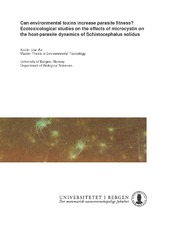Can environmental toxins increase parasite fitness? Ecotoxicological studies on the effects of microcystin on the host-parasite dynamics of Schistocephalus solidus
Master thesis
Permanent lenke
https://hdl.handle.net/1956/23863Utgivelsesdato
2020-08-21Metadata
Vis full innførselSamlinger
- Master theses [269]
Sammendrag
Background: Eutrophication of aquatic biomes and exacerbated climate change effects are expected to result in a global increase in harmful cyanobacterial blooms. Cyanotoxins are detrimental to animal health, but how they affect the dynamics within ecosystems is still mostly unknown. With a host-parasite system acting as a microcosm, I wanted to explore the changes in host-parasite dynamics with a cyanotoxin present. Methods: In a set of laboratory studies with the copepod-Scistocephalus solidus system, I looked at the host-parasite dynamics in the presence of the hepatotoxin microcystin. In four different groups (control, toxin-only, infection-only, toxin-infection combined) of individually isolated copepods, I examined if mortality increased in the first intermediate host, or if the toxin would increase mortality or curb the growth in the parasite. Results: While the presence of toxin alone increased copepod mortality significantly, microcystin did not exhibit any toxin-parasite interaction leading to increased mortality. However, the host’s ability to hinder parasite growth was affected. Since tapeworms accumulate environmental toxins, I expected a lower growth rate of the parasites in the toxin group, but procercoids from toxin-parasite groups were found to have a significantly larger surface area (P.007) than procercoids from the infection-only group. Conclusions: The increased growth of parasites in the presence of microcystin, suggests a change in the host-parasite dynamic. While host mortality was not significantly affected by the parasite infection. Increased procercoid growth points to a rise in pathogen virulence or weakened immunity in the host, which could be detrimental in less robust host individuals.
